Braiding a horse’s mane is not just about aesthetics; it’s an art form that reflects the deep bond between horse and rider. Whether for a horse show, dressage, or simply the love of grooming, learning how to braid a horse mane can be a rewarding experience. With patience and practice, you can master various equestrian braid styles, enhance your horse’s appearance, and protect its mane. This comprehensive guide will lead you through the process, offering tips and techniques for braiding horse hair, so you can achieve that show-worthy look.
Exploring Mane Braiding Techniques
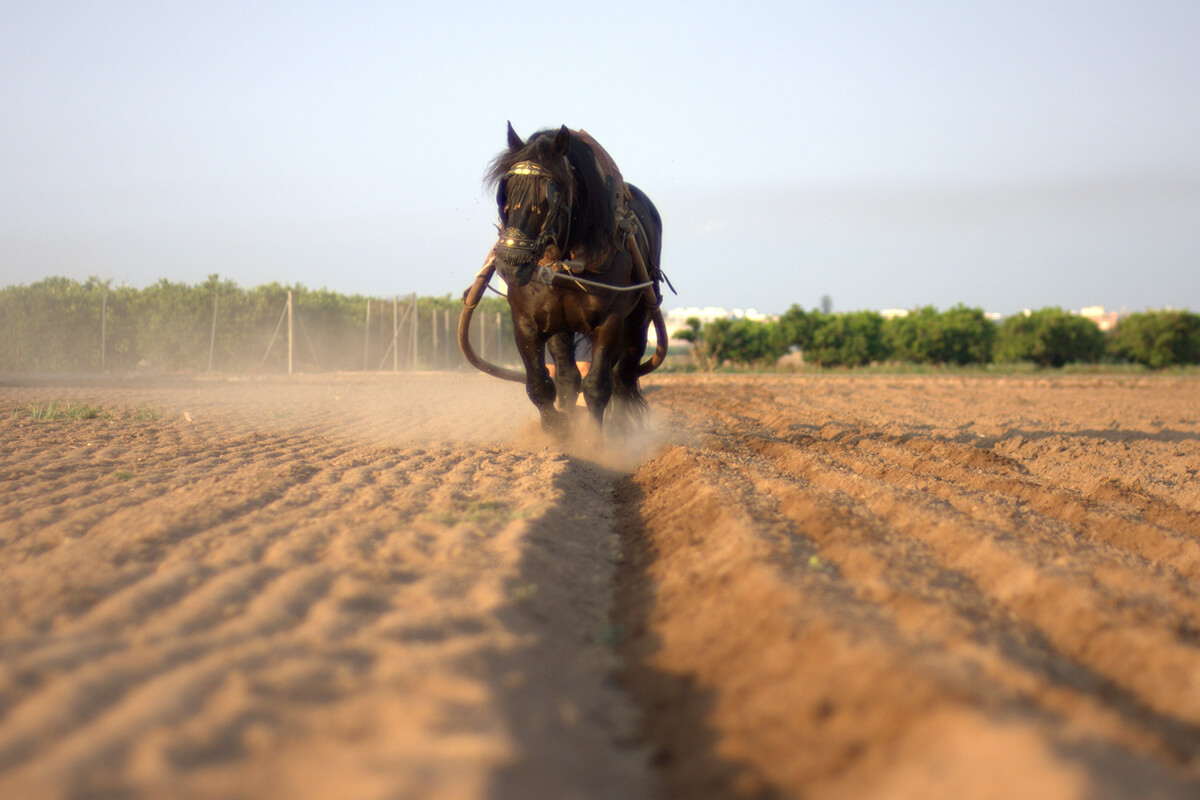
Delving into the intricacies of mane braiding, this section aims to empower equine enthusiasts with enhanced techniques for their horse’s mane. We will expand your skill set, ensuring you’re well-prepared to create elegant braids that are both protective and pleasing to the eye.
Mane Characteristics and Braiding Adaptability
Each horse’s mane presents unique braiding challenges due to varying textures and lengths across breeds. A well-cared-for mane is the foundation for successful braiding, contributing to the overall visual appeal and mane health by minimizing tangles and dirt accumulation.
Expressing Care Through Braided Manes
Braids are more than a grooming routine; they’re a testament to the attentive care a handler provides. The precision involved in braiding is a clear indicator of this dedication, ensuring the horse’s appearance is tidy, especially during rigorous activities, and helps avoid mane entanglement.
Advantages of Mane Braiding in Competitive Arenas
For equestrian competitions, including dressage, meticulously braided manes present several benefits:
- Enhancement of the horse’s natural elegance
- Clearer visibility of the horse’s anatomical lines for evaluators
- Adherence to specific braiding styles as dictated by competition standards
These advantages highlight the crucial role of braiding in the dressage arena and its potential impact on the judges’ impressions and scores.
Selecting a Suitable Braiding Style
When choosing a braiding style, consider the event’s guidelines, the horse’s mane characteristics, and the style’s longevity. The right choice will ensure the horse’s comfort and deliver a fitting and attractive look for the occasion.
Braiding Evolutions in Equestrianism
Equestrian fashion has evolved, welcoming new braiding techniques that allow for a mix of time-honored traditions and contemporary styles. Riders are now encouraged to bring their own creative touch, reflecting both their personality and their horse’s, to the competitive stage.
Key Practices for Mane Braiding Proficiency
For proficient mane braiding, it is essential to:
- Maintain consistency in the size and tension of braids
- Opt for braiding bands that blend seamlessly with the mane
- Keep the mane well-groomed to simplify the braiding process
Adherence to these principles will help ensure a braided mane that is not only striking but also conducive to the horse’s welfare and competitive edge.
Preparation Steps for Braiding Equine Manes

Embarking on the journey of DIY horse mane braiding involves not only skill and patience but also the preliminary steps to ensure a polished end result. This segment will cover the essential preparation steps to pave the way for an effortless and effective braiding session, ultimately contributing to your horse’s refined and sophisticated presentation.
Checklist of Supplies for Mane Braiding
Before commencing the braiding process, it’s important to assemble the right tools for the task. Here’s a list to help you gather what you’ll need:
- A mane comb for detangling.
- Elastic braiding bands for securing the braids.
- A spray bottle with water or braiding spray to help manage the hair.
- Scissors for any necessary trimming.
- Yarn or thread for sewn braids or adding flair.
- Hair clips for sectioning off the mane.
- Braid aid for improved grip during the braiding process.
Cleaning and Detangling: Essential Mane Prep
A clean mane is the canvas for braiding. Begin with a thorough wash using equine-friendly shampoo, then ensure complete rinsing to prevent any leftover residue. Allow the mane to dry naturally or with a gentle blow dryer before combing it out meticulously to remove all tangles, which will facilitate a smoother braiding session.
Conditioning the Mane Before Braiding
A mane that’s healthy and well-maintained typically yields better braiding results. Applying a mane conditioner or detangler post-wash can enhance the braiding process, making the hair more manageable. Ensure even application and comb through to spread the product, setting the stage for easier braiding.
Organizing Mane Sections for Even Braids
For braids that are consistent in appearance, it’s crucial to divide the mane into uniform sections. Use your mane comb and potentially hair clips to partition the hair into even segments, keeping in mind the total number of braids you aim to create. Dampening each section slightly can aid in maintaining control of the hair and minimizing stray strands during the braiding process.
Optional Mane Trimming for Enhanced Neatness
Trimming the mane may not be necessary for all braiding styles, but doing so can result in a neater appearance. If you decide to trim, do so with precision, considering the requirements of your chosen style, as some braids may necessitate longer hair to remain secure.
With your supplies in order and the mane well-prepped, you’re all set to begin the fulfilling process of DIY horse mane braiding, fostering not only an attractive look but also promoting the ongoing health and condition of your horse’s hair.
Enhancing Your Horse’s Beauty: Advanced Braiding Techniques
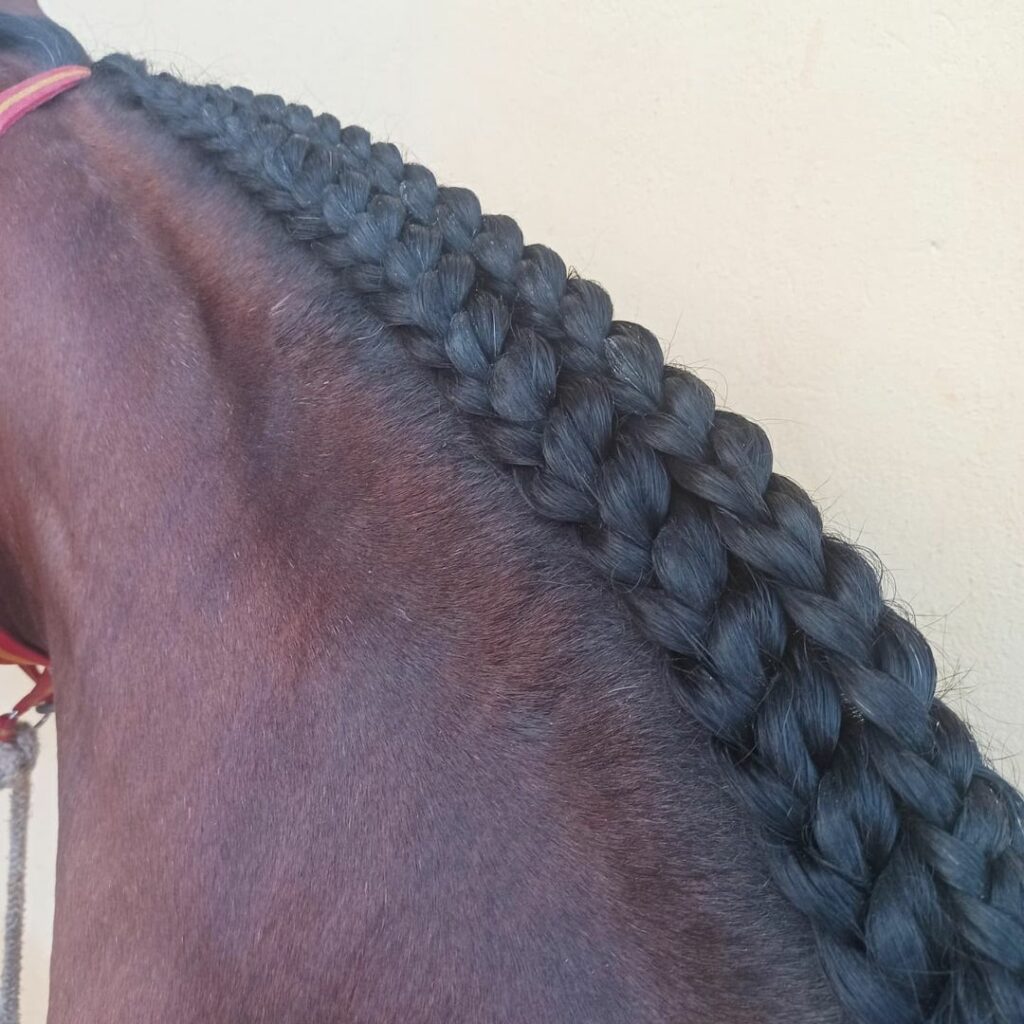
Braiding a horse’s mane can substantially improve its appearance while showcasing your grooming proficiency. Whether you’re just starting or are an experienced groomer, we’ll delve into the world of intricate braiding, from foundational plaiting to more advanced and decorative styles, helping you to elevate your technique for any occasion.
Getting Started with Simple Braids
Beginning with straightforward braiding methods is essential for anyone new to this craft. These initial techniques form the basis for more elaborate braid patterns in the future. For a simple start:
- Choose a manageable portion of the mane and divide it into three even strands.
- Alternately cross the strands over the middle one to create the braid.
- Proceed with this pattern to the hair end, then fasten with an elastic band that matches the mane color for a clean look.
The Classic Three-Strand Braid: A Step-by-Step Guide
The age-old three-strand braid remains a favorite for its adaptability and elegance. It suits various occasions, from casual outings to formal competitions. Here’s how to perfect this style:
- Separate a mane section into three equal parts.
- Cross the strands over each other in an alternating fashion to form a snug, uniform plait.
- Maintain even pressure to avoid loosening and secure the end with an inconspicuous band.
Refining Your Plaiting Skills for Dressage and Shows
Refinement and accuracy in braiding are particularly crucial for dressage and showing. To craft these meticulous plaits:
- Commence with a clean, knot-free mane for an unblemished work surface.
- Equally partition the mane, preparing each for its individual plait.
- Intertwine the strands firmly, ensuring uniform tension is applied.
- Finish by fastening the plaits close to the neck using thread or bands.
Introducing Personal Flair to Braids
Once you’ve mastered the fundamental braiding styles, you can experiment with personalized touches to your horse’s braids. To add unique elements:
- Incorporate vibrant ribbons or beads for a splash of color.
- Alter braid sizes or craft patterns to introduce visual variety.
- Adorn braids with accessories such as flowers or charms for a custom look.
Keep in mind that any additions to the braids should not interfere with the horse’s comfort or well-being.
Custom-Tailored Braids for Celebratory Events
Distinctive braiding is often required for unique celebrations. Tailor your braiding approach to enhance the festivity of the event:
- For holidays, weave in colors or ornaments that reflect the spirit of the celebration.
- Wedding braids can be embellished with white ribbons or soft blossoms.
- Themed photoshoots allow for creative license with braid arrangements and coordinating adornments.
When brainstorming braids for special occasions, always align the mane’s style with the event’s overall theme and wardrobe to achieve a harmonious and polished ensemble.
Refining Equestrian Braiding Artistry
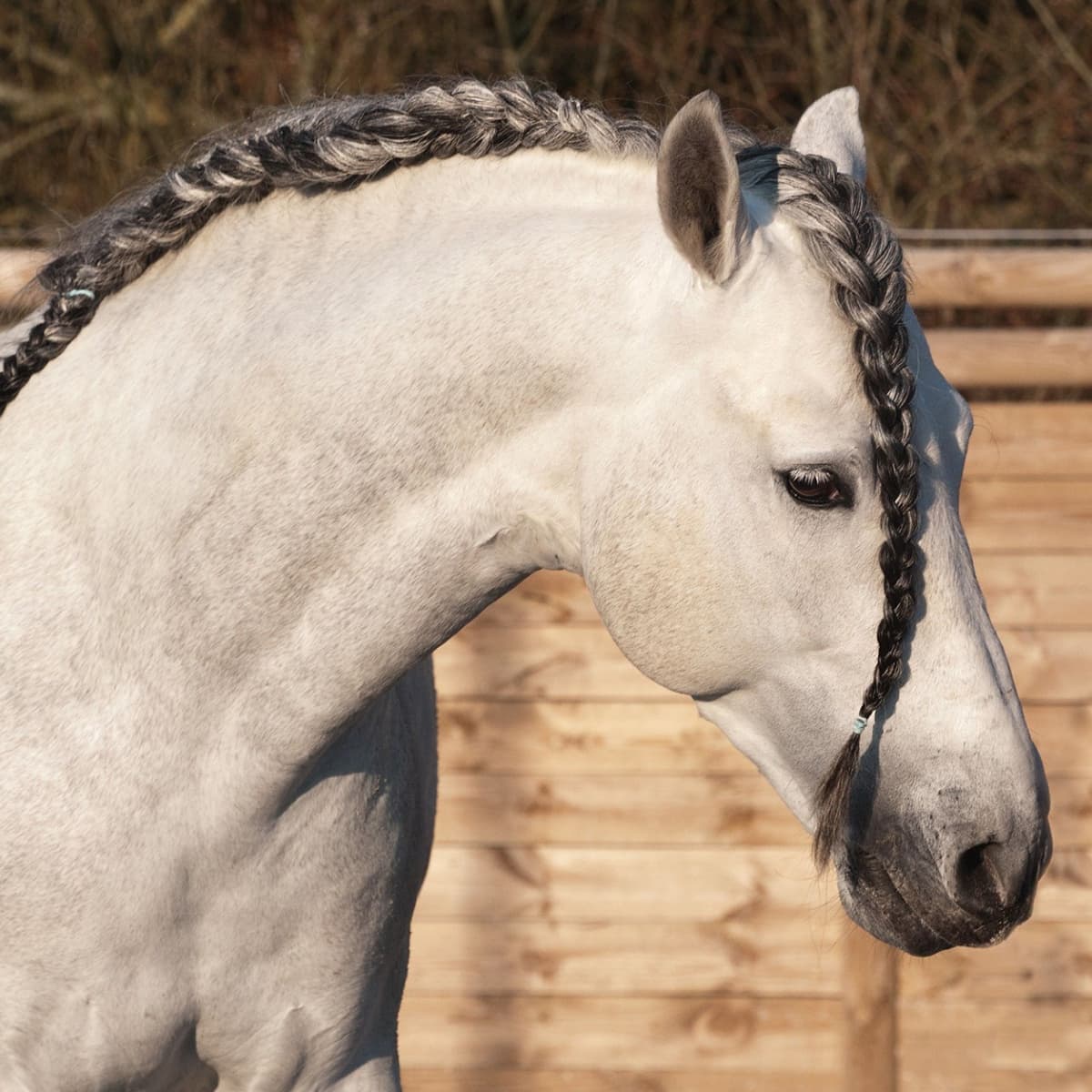
Advancing your braiding skills can distinguish your horse in competitive realms, showcasing your dedication to the sport. This segment provides insights into the intricacies of advanced braiding, equipping you with the ability to craft complex braid patterns that enhance your horse’s competitive poise.
Professional Braiding for Dressage Elegance
For dressage, the horse’s turnout is a testament to the rider’s professionalism. Complex braids like the button or rosette not only serve an aesthetic purpose but reflect the rider’s thoroughness. Here’s how to execute these sophisticated braids:
- Partition the mane into evenly spaced segments, the number of which depends on the hair’s density.
- Tightly plait each section, then fold the braid into its designated shape snugly along the neck crest.
- Use needle and thread for secure attachment, ensuring durability throughout the event.
Impeccable Braiding for Horse Shows
Meticulous braiding preparation can significantly influence your horse’s appearance in the show ring. Achieving uniform braids demonstrates a handler’s precise care. Focus on these aspects for flawless horse show braids:
- Equal sections: Divide the mane equally to ensure symmetrical braids.
- Even tension: Keep consistent pressure for braid integrity and the horse’s comfort.
- Inconspicuous fastening: Select thread or bands that blend with the mane for a seamless hold.
Accentuating Braids with Elegance
The final touches of securing and accessorizing braids are critical to the overall look. Here’s how to ensure longevity and enhance beauty:
- Fasten braids with color-coordinated thread or clear bands for a discreet grip.
- Apply hairspray lightly to smooth stray hairs and add a soft luster.
- Add simple, elegant embellishments that enhance without overwhelming the horse’s natural allure.
Tail Braiding for Harmonious Elegance
Complement a beautifully braided mane with a meticulously done tail to complete the look. This requires the same precision:
- Ensure the tail is clean and conditioned prior to braiding.
- Begin at the top of the tail, weaving in more hair as you progress downward.
- Finish the braid at the bottom, opting for a free-flowing or looped style, depending on the desired effect.
Exploring Braiding Innovations
For those eager to expand their braiding repertoire, advanced patterns offer a new level of artistry:
- Try out lattice or baroque patterns for a majestic touch.
- Incorporate herringbone or fishbone braids for a rich, textured look.
- Challenge yourself with multi-strand braids for an intricate and captivating style.
Adopting these advanced techniques for dressage and horse show events enhances your horse’s appearance and reflects your grooming prowess. Consistent practice is vital to master these elaborate styles, preparing you to present your horse with confidence and style.
Nurturing a Braided Mane: Post-Styling Care and Tips
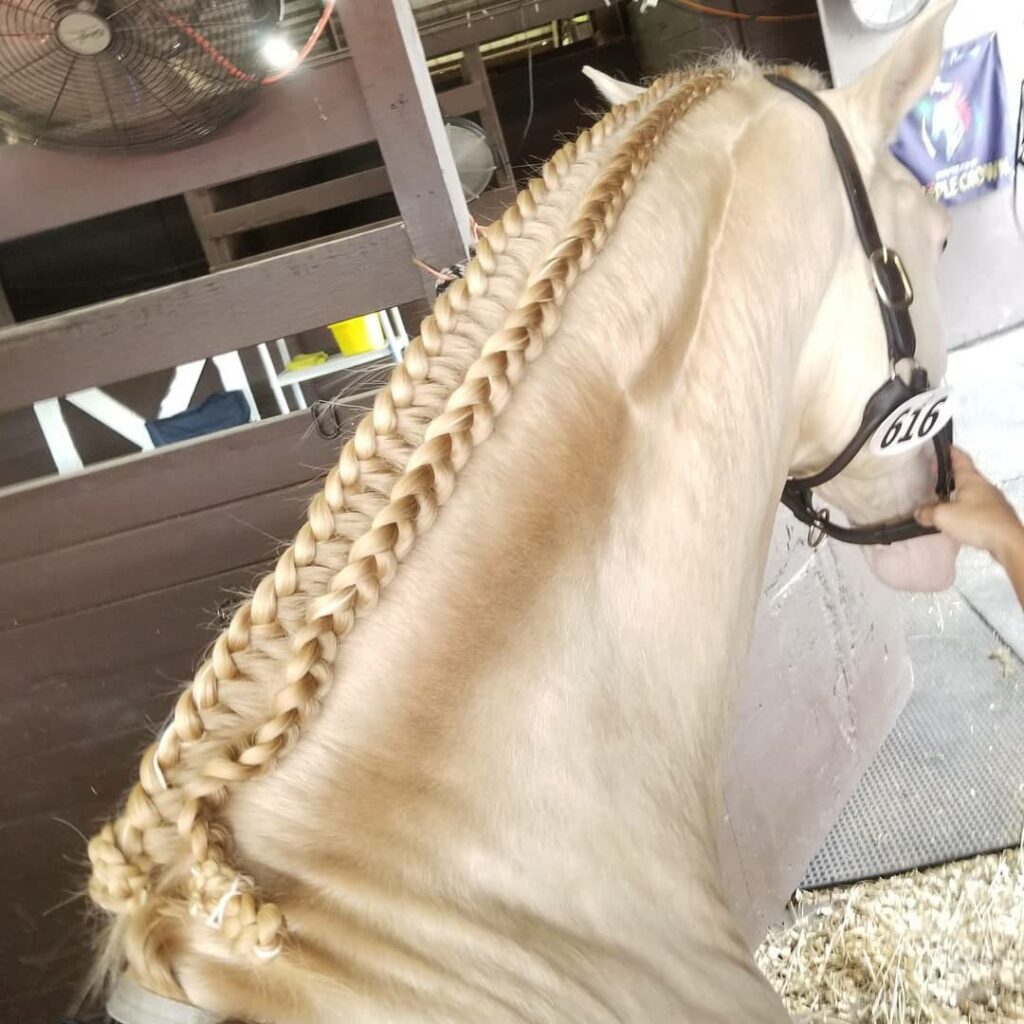
After achieving the perfect braid, it’s important to focus on the aftercare of your horse’s mane to maintain its health and prevent any damage from the styling process. This part of the guide will provide essential advice on how to care for your horse’s mane once the braids have been styled.
Moisturizing and Shielding the Mane
Post-styling, it’s vital to ensure the mane remains hydrated to avoid dryness and breakage:
- Use a high-quality mane conditioner regularly to maintain moisture levels.
- If braids are kept for extended periods, consider a protective cover such as a mane bag to guard against environmental damage.
These steps help keep the hair supple and resilient.
Guidelines for Unbraiding
When it’s time to undo the braids, handle the mane with care to preserve its condition:
- Detach braids carefully, minimizing tension on the hair.
- Keep braids in no longer than seven days to avoid matting and stress.
- After unbraiding, engage in a grooming session that includes detangling and applying a leave-in conditioner.
Correct unbraiding procedures are crucial for maintaining a healthy mane.
Resting Intervals for the Mane
Allowing the mane time to rest and recover from braiding is essential:
- Schedule periods where the mane can hang freely.
- During these breaks, conduct extensive grooming and check for any damage.
These rest periods are vital for sustaining the mane’s overall health.
Treating Braid-Related Mane Damage
On occasion, braiding may lead to mane damage, which should be addressed promptly:
- Look out for early indications of wear such as thinning or breakage.
- Apply specialized treatments like restorative masks or serums to affected areas.
- Seek professional advice for severe issues like extensive hair loss or skin conditions.
Proactive treatment is key to mitigating further harm and encouraging mane recovery.
Ongoing Mane Evaluation
Regularly assessing the mane after braiding can help avert long-term complications:
- Inspect the mane often for signs of wear or damage.
- Record the mane’s status to track any changes over time.
Such monitoring facilitates the early identification and treatment of any issues.
Reinforcing Mane Durability
There are steps you can take to fortify the mane against the effects of braiding:
- After veterinary consultation, integrate supplements into your horse’s diet that benefit hair health.
- Apply sprays or serums with UV protection to shield the mane from sun damage, particularly during sunny seasons.
Internal nourishment and external protection are crucial for a robust mane that can endure styling.
Adapting Mane Care to the Environment
Environmental factors significantly influence mane care routines:
- In damp conditions, be proactive with antifungal treatments to prevent growth of fungi.
- In dry climates, increase conditioning frequency to prevent the mane from dehydrating.
Customizing your mane care to the surrounding conditions is essential for mitigating environmental impacts.
By adopting these post-braiding care strategies, you can enjoy the beauty of intricately styled manes without compromising their health. Regular hydration, gentle unbraiding, and allowing for recovery are foundational practices for a well-maintained mane. Adherence to these principles will ensure that your horse’s mane continues to exhibit both strength and splendor.
Conclusion
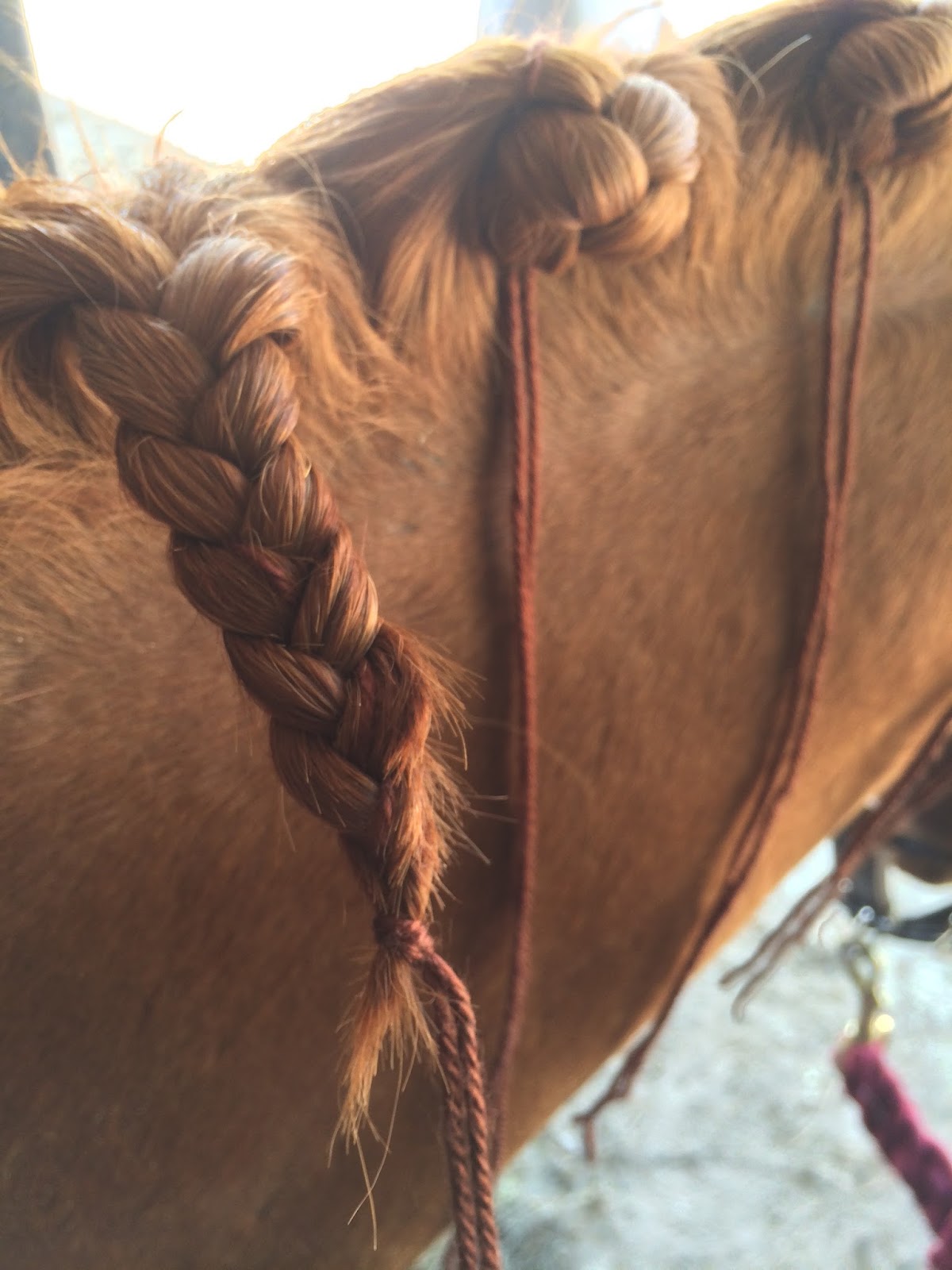
Recap of Braiding Techniques and Styles
In this guide, we’ve explored the fundamentals of how to braid a horse mane, from simple horse mane braids to the more elaborate dressage horse mane braiding. We’ve covered the importance of preparation, the step-by-step braiding process, and the finishing touches that make for a standout mane.
Encouragement to Try Creative and DIY Braiding
With practice, braiding horse hair can become an enjoyable and creative hobby. Whether you’re preparing for a competition or grooming for pleasure, trying your hand at DIY horse mane braiding can be both rewarding and fun. So grab your supplies, and let the braiding begin!



